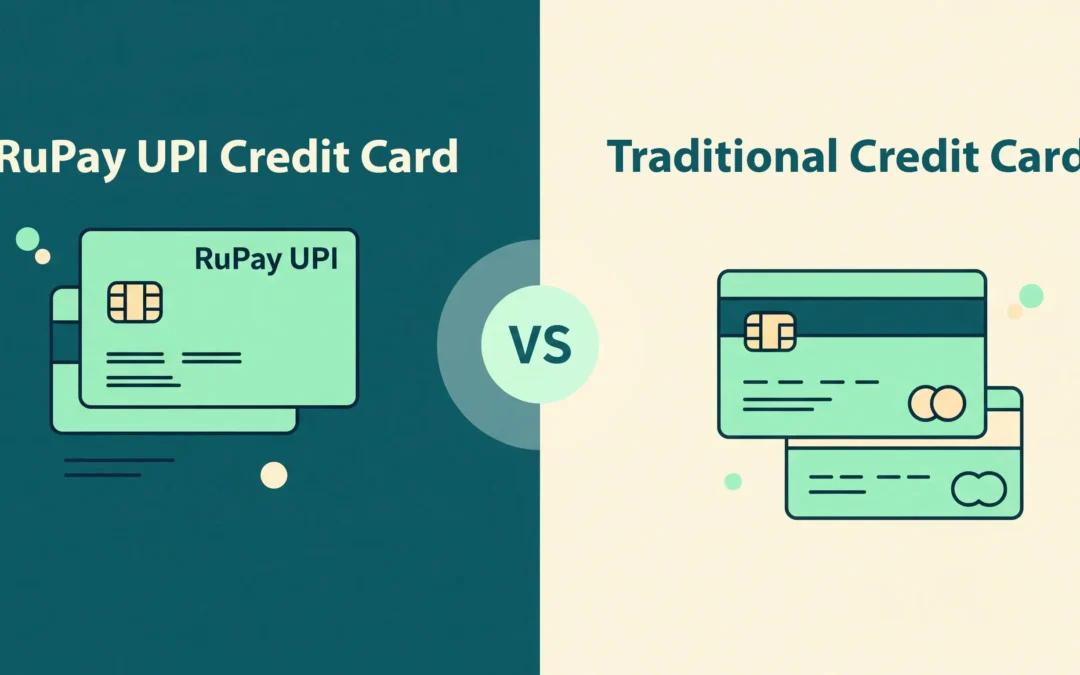Credit cards have evolved from plastic rectangles to multipurpose financial instruments in India’s quickly changing digital payment environment. The RuPay UPI Credit Card, a hybrid that combines the convenience of UPI with the strength of credit, is one of the most recent innovations. However, how does it compare to the well-established conventional credit card? Knowing the distinctions between these two options can help you make better financial decisions, regardless of whether you’re a frequent traveller with high spending requirements or a student just starting out with credit.
Let’s examine their differences and determine which one might be the best choice.
What Is a RuPay UPI Credit Card?
The National Payments Corporation of India (NPCI) unveiled the ground-breaking RuPay UPI Credit Card, which combines the advantages of a credit card with the ease of UPI. This innovation enables users to link their RuPay credit cards to UPI apps such as PhonePe, Google Pay, Paytm, and BHIM, allowing for seamless payments using the credit limit rather than the bank balance. Previously, UPI transactions were restricted to direct bank account debits.
Example: A UPI QR code is displayed at the local kirana shop where you are shopping. You use Google Pay to scan the code and select your associated RuPay credit card rather than your bank-linked UPI. Although the transaction goes through UPI, the money is taken out of your credit card balance rather than your savings account.
What Is a Traditional Credit Card?
Banks and credit card companies issue traditional credit cards, which are financial products that let you borrow money to pay for goods and services up to a pre-approved credit limit.
With a traditional credit card, the issuer pays for your purchase up front, and you have to pay them back in full or in installments each month. Traditional credit cards frequently offer extra benefits like reward points, cash-back deals, travel benefits, and fraud protection in addition to the ability to borrow money. Additionally, they contribute to the development of your credit history, which is essential for future loan applications and improved financial products.
RuPay UPI Credit Card vs Traditional Credit Cards: What’s the Difference?
The following will help you make a clear distinction between both.
| Feature | RuPay UPI Credit Card | Traditional Credit Card |
| Issuer Network | RuPay (India-specific) | Visa, Mastercard, Amex, etc. (Global networks) |
| Usage Mode | Linked to UPI apps (Google Pay, PhonePe, BHIM) | Physical card or card number used on websites/apps |
| Payment Method | UPI QR scanning (merchant-side) | Swipe, chip, or tap at the POS or card details for online |
| UPI Integration | Yes, you can pay via UPI using credit | Not supported by UPI |
| Merchant Acceptance | QR-code-enabled local merchants | POS-enabled stores and online platforms |
| Credit Period | Up to 45-50 days (standard) | Up to 45-50 days |
| Reward Points | Basic to moderate (depends on the bank) | Wide range of rewards, cashbacks, and offers |
| Transaction Cost (MDR) | Lower (beneficial for small merchants) | Higher (less merchant-friendly) |
| Best Use Case | UPI-based local purchases, small businesses | High-value shopping, global travel, luxury perks |
| Eligibility | Generally easier to get | May require a higher credit score/income proof |
Choose a RuPay UPI Credit Card if:
- Prefer UPI payments: Do you frequently scan QR codes at local vendors, tea stalls, or kirana shops? With RuPay UPI Credit Cards, you can make credit-based payments without a swipe machine by using UPI apps like PhonePe and Google Pay.
- You’re looking for a low-maintenance credit card: Numerous RuPay credit cards have reduced or no annual fees. This card is ideal if you’re on a tight budget and don’t want to deal with complicated fee structures.
- You wish to raise your credit score because you are new to credit: Using a credit card for the first time? You can access credit with a RuPay UPI Credit Card in an easy-to-manage, digital-first format. It is perfect for students, beginners, or young professionals.
Choose a Traditional Credit Card if:
- You go overseas or shop on websites from other countries: Organizing travel or making purchases on websites like AliExpress or Amazon Global? Unlike RuPay, which is mostly based in India, traditional credit cards like Visa, Mastercard, or Amex are accepted everywhere.
- You enjoy earning cashback, rewards, and travel benefits:
More extensive loyalty programs are frequently available with traditional cards,- Points for each purchase
- Fuel, dining, and grocery cashback
- Access to airport lounges and travel insurance
- Ideal for consumers who wish to get more out of each swipe.
- You want protection and special privileges: Do you require services like EMI options, fraud insurance, concierge services, or purchase protection? These are excellent for high-income users or regular shoppers and are frequently included with luxury traditional credit cards.
Bottomline
Traditional credit cards and RuPay UPI credit cards both have special benefits catered to various user lifestyles. RuPay UPI cards provide a simple, affordable way to get started with credit and are ideal for regular digital payments, particularly at nearby retailers. Traditional credit cards, on the other hand, are more appropriate for reward-seeking consumers who value first-rate services, international travel, and internet shopping.
Ultimately, your lifestyle, financial objectives, and spending patterns will determine which option is best for you. Some might even profit from owning both, one for worldwide flexibility and benefits and the other for UPI convenience.
Written by: Tanya Kumari


